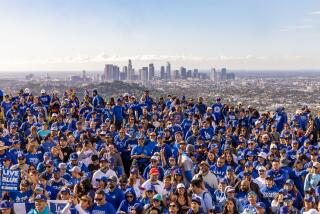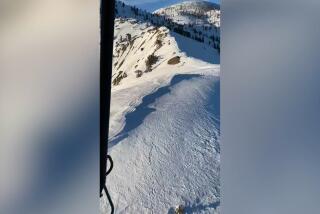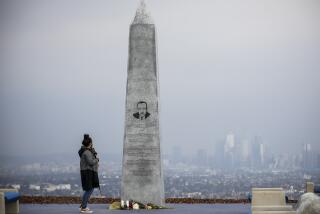Op-Ed: What’s missing when you hike the California backcountry? People of color
Last month, two friends and I backpacked for a week in the Sierra Nevada. We hiked through meadows dotted with wildflowers, slept beneath snow-draped peaks and met plenty of other hikers: the dad and son whose Green Bay Packers caps sparked a conversation about our mutual ties to Wisconsin; scientists from UC Santa Cruz studying flowers and rock formations; five recent college grads from Kentucky who were hiking the John Muir Trail before they scattered to begin their adult lives.
But as the days passed, I grew increasingly troubled by the people we didn’t meet. There were a few Asian hikers, including a couple of hapas like me (I’m half Japanese and half Polish) and one of my friends was half-Iranian, but not a single backpacker who was Latino or African American.
A few hours’ drive from Los Angeles ... we were on public lands ... but the people enjoying them weren’t representative of the public.
This near-total absence of people of color — which I’ve noticed on past trips as well — was particularly striking because it was such a contrast to my everyday life. I live and work in Los Angeles. The majority of people in my working life are Latino, African American or Asian, and the people in my personal life, including my Mexican American spouse, are reflective of the city’s population. And yet, a few hours’ drive from Los Angeles, there was hardly a person of color to be found. We were on public lands — including Kings Canyon National Park — but the people enjoying them weren’t representative of the public.
This month, as the National Park Service celebrates its centennial, it is publicizing efforts to increase the diversity of its visitors — who according to its own survey are nearly 80% white — as well as its staff. Mainstream environmental groups like the Sierra Club, which recently hired its first director of diversity, equity and inclusion, are trying to counter the impression that the outdoors is a privileged domain for white people. One take on this problem is the biting video short “Black Hiker,” in which Blair Underwood’s nature-loving character is tracked and photographed by whites who are stunned, delighted and a little confused to find a black man in their midst.
There are reasons, of course, why people of color are underrepresented in the backcountry. For many, the wilderness, historically, is dangerous territory. Escaped slaves passed through forests full of danger, much of it posed by other people. Mexican and Japanese immigrants and African American sharecroppers worked to exhaustion in the fields. These brutal histories may help explain why some groups might not be drawn to the idea of spending time — let alone sleeping — outdoors.
Yet it’s simplistic and inaccurate to think that people of color don’t appreciate nature. The trails in Griffith Park and above Pasadena are filled with hikers who look like Los Angeles. On weekends, the city’s biggest parks and its other outdoor venues are enjoyed by families of all ethnicities and races.
My own relationship with nature began in the Midwest. As a child, I was sent from Tokyo to live with my grandparents in rural Wisconsin. I faced incessant, sometimes violent bullying from the white children in town. To escape, I’d ride my bike out to the country and take solace in the trees and the quiet. Right after college, I moved back to Japan for two years, living in a small mountain town where everyone hiked and rode bicycles. Behind my apartment was a green jewel of a mountain, and when I scrambled up its slopes, I’d reach a Shinto shrine that offered a view of the entire region. My understanding of the natural world was not something separate from race, but completely entangled with it. Nature was a place of safety from racial targeting; hiking was something that people of color did.
America’s wildest, most beautiful places, though, are still largely white. One way to change that is simple exposure: Blair Underwood likes hiking because he was introduced to it as a kid. Respondents to the Park Service survey cited expense as a barrier, but lack of knowledge about the parks was an even bigger one.
Absent a family tradition of spending time in nature, would-be visitors may need translators or guides who make the parks and wilderness areas accessible. Shelton Johnson, an African American ranger at Yosemite, teaches visitors about Buffalo Soldiers. Outdoor Afro, Latino Outdoors and Asian Outdoors — nonprofit organizations — link people of color to nature. The Boy Scouts and Girl Scouts teach outdoor skills to diverse groups of young people.
Conscious outreach efforts would also make a difference. “We’ve got kids all across this country who never see a park,” President Obama said when he and his family were photographed at Yosemite in June. “We have to change that.” Outreach efforts should recognize that, for many minority groups, nature as a backdrop for family activities is a better sell than adrenaline-soaked adventure language about “conquering mountains.”
And then there is the matter of safety. In some rural areas, there is reason to be cautious. Last year, a black family at a campsite in Nevada County was terrorized by a drunken white camper yelling racial epithets and wielding a shovel. In July, my friends and I spent the first night of our trip near a pack station where a truck owned by one of the staff sported a Confederate flag in its window. I’ve never faced or witnessed a racial incident in the backcountry, but I’ve definitely seen racist expressions in the jumping-off towns, which reinforce the idea that the wilderness isn’t safe for everyone.
Connecting people of color with nature matters because the very existence of the nation’s public lands is threatened if they aren’t enjoyed by a broad cross-section of our population. It matters because getting “out there” makes people more attuned to issues like green space and pollution back home. And it matters because science confirms that exposure to nature is good for us all. For years I’ve joined groups of South L.A. kids on camping trips, where I’ve watched their spirits unburden, their imaginations bloom, as they escape from city life and in some cases the specter of daily violence.
Finally, diversifying the outdoors matters because equity and access matter. People of color, particularly children of color, deserve the same possibility of beauty and transcendence as white people.
In July, I hiked up the wind-blown mountain passes, through shaded forests, beside alpine lakes. These places are among the loveliest gifts our country has to offer. They belong to us too.
Nina Revoyr was a longtime executive at a children’s services organization in Los Angeles. She is the author of several novels, including “Lost Canyon.”
Follow the Opinion section on Twitter @latimesopinion and Facebook
MORE FROM OPINION
Fretting the un-manning of America
Can epistocracy, or knowledge-based voting, fix democracy?
More to Read
A cure for the common opinion
Get thought-provoking perspectives with our weekly newsletter.
You may occasionally receive promotional content from the Los Angeles Times.






